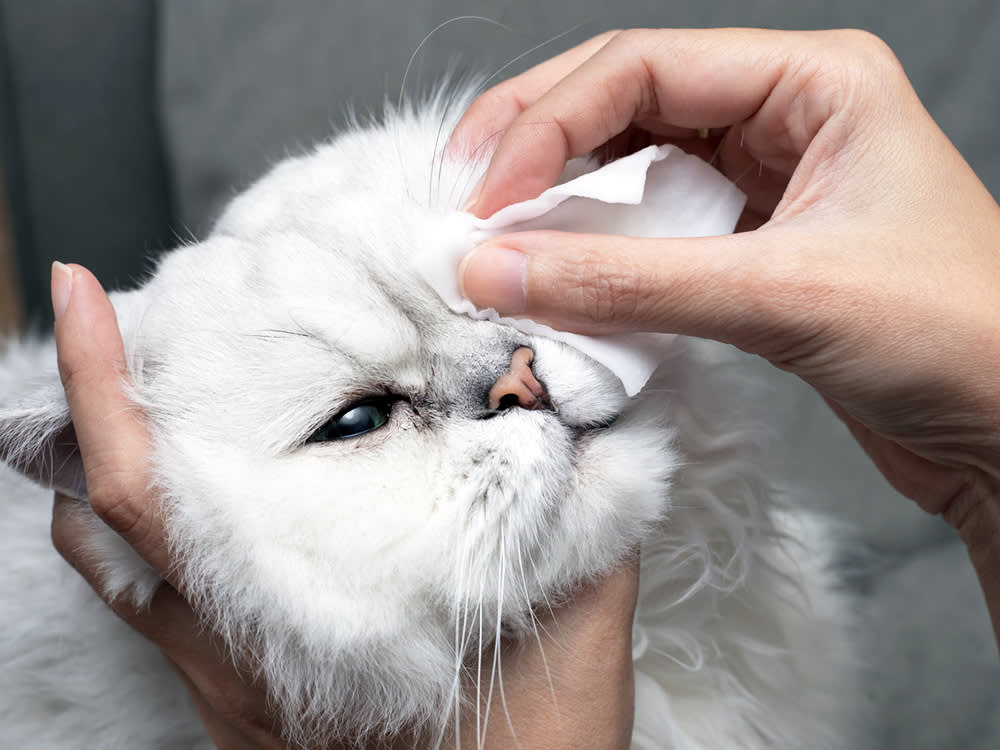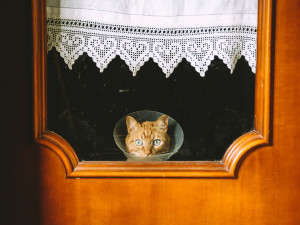Can Cats Get Pink Eye? The Signs, Symptoms, and Treatments
The answer isn’t cute, but here’s how to help your kitty.

share article
In This Article:
How Do Cats Get Pink Eye? opens in a new tab Is Feline Pink Eye Contagious to Humans?opens in a new tab Symptoms of Conjunctivitis in Cats opens in a new tab Treating Feline Pink Eye Safely opens in a new tab Preventing Pink Eye Transmission opens in a new tab When Is Vet Care Essential?opens in a new tab
Cats can get conjunctivitis — commonly called pink eye — from viral, bacterial, or environmental causes. Pink eye leads to symptoms including eye discharge, irritation, redness, and swelling. Staying up-to-date on vaccinesopens in a new tab, practicing good hygiene, and seeking veterinary care for eye issues are crucial for addressing pink eye in cats.
How do cats get pink eye?
Conjunctivitis, or pink eye, is one of the most commonly diagnosed eye issues in catsopens in a new tab. Conjunctivitis is the inflammation of the conjunctiva, the thin tissue that lines the inner eyelids and the whites of the eyes.
Most cases of conjunctivitis in cats are due to infectious causes opens in a new taband are highly contagious. Common causes of pink eye in cats include viral infections, bacterial infections, and environmental irritants. Pink eye can also develop secondary to other eye issues, such as glaucoma, dry eye, or trauma to the eye.
Viral conjunctivitis
Most cases of feline conjunctivitis are from underlying viral infections. Feline herpesvirus type 1 (FHV-1) is the most common viral cause of pink eye in cats. Feline calicivirus is a close second.
Bacterial conjunctivitis
Chlamydophila felis and Mycoplasma spp. are common bacterial causes of feline conjunctivitis. Chlamydia is especially common in young kittens. Cats with viral conjunctivitis often have secondary bacterial infections.
Parasitic conjunctivitis
Though uncommon, cats can develop conjunctivitis from parasites. Cuterebra (rodent bot fly) larvae, Leishmania spp. (protozoa), and Thelazia spp. (eye worms) are ocular parasites that can cause pink eye in cats.
Physical irritation
Environmental allergens, such as dust, smoke, potpourri, spray cleaners, and other chemicals can cause irritation and inflammation in a cat’s eyes. Trauma from scratches or foreign objects can also cause non-infectious conjunctivitis in cats.
Is feline pink eye contagious to humans?
Luckily, a human getting pink eye from a cat is very rare. Humans cannot get herpes virus or calicivirus from cats. These viral infections are only contagious to other cats. However, humans can get bacterial infections with Chlamydophila felis and Mycoplasma spp. from cats. Immunocompromised individuals are at higher risk, but all cat parents should practice good hand hygiene and seek prompt veterinary care for cats with conjunctivitis.
Symptoms of conjunctivitis in cats
Conjunctivitis can affect one or both eyes and is often accompanied by general symptoms of upper respiratory infection. Symptoms of pink eye in cats include:
Eye discharge (clear, mucoid, or green)
Swelling around the eye
Squinting
Redness of the sclera (the whites of the eyes)
Red and swollen third eyelid
Rubbing or pawing at the eye
Excessive tear production
Excessive blinking
Sneezing
Nasal discharge
Treating feline pink eye safely
Most cats with pink eye have underlying chronic viral infections, so treatment often involves trying to resolve the acute inflammation and discomfort. Many times, cat parents are tasked with administering eye dropsopens in a new tab or ointments into inflamed, painful eyes. This may seem impossible to some pet parents, but veterinary staff can provide tips to make at-home treatment a little easier. Treatment for conjunctivitis in cats may include:
Antibiotics (oral or topical)
Antiviral medication (oral or topical)
Artificial tears
Stress reduction
Steroids (only in certain cases)
Warm compress on the eyes (to help wipe the eye boogers away)
Elizabethan collar, aka a cone (to prevent excessive rubbing)
Environmental adjustments
Preventing pink eye transmission
Infectious conjunctivitis spreads easily in environments with multiple cats, like shelters, catteries, and multi-cat households. The closer the living quarters, the higher the likelihood of transmission. Not every case of conjunctivitis in cats is preventable, but cat caretakers can take these steps to reduce risk of disease.
Isolate sick kitties: Cats with signs of conjunctivitis or upper respiratory disease should be kept separate from other cats to help keep infections from spreading.
Stay current on vaccines: Feline calicivirus (FCV) and feline herpesvirus-1 (FHV-1) are both considered core vaccines for cats and can help reduce the risk for conjunctivitis.
Practice good hygiene: Wash your hands after handling cats (especially sick ones). In multi-cat homes, clean litter boxes, food bowls, and other shared objects regularly.
Minimize stress: Cats with herpes virus can harbor latent infections, meaning the virus lays dormant. Stress can trigger the virus to become active, leading to symptoms like conjunctivitis. Minimizing stressopens in a new tab can help reduce the risk of flare-ups.
Eliminate irritants: Keep the environment free of potential eye irritants like smoke, dust, and chemical sprays.
Pet parents often wonder if their dogs can get pink eye from a cat. The bacteria that cause pink eye in cats generally don't cause the same problem in dogs, but it’s still a good idea to practice good hygiene and isolation just in case, especially if your dog has any health problems that may affect their immune system.
When is vet care essential?
Cat parentsopens in a new tab should seek veterinary advice any time they notice a change in their cat’s eyes. Most cases of conjunctivitis resolve quickly with prompt care. Even if a cat has recurrent flare-ups, seeking veterinary advice is still important. Herpes virus may be forever in cats, but conjunctivitis does not have to be. Left untreated, cats can develop deep corneal ulcers, leading to blindnessopens in a new tab or the need for eye removal.
FAQs (People also ask):
Can cats get pink eye in one eye?
Cats can get conjunctivitis in just one eye, especially if it’s due to a non-infectious cause. In cases of infectious conjunctivitis, symptoms can start in one eye before spreading to the other.
How do you give eye drops to cats?
Carefully. Use a towel for gentle restraint. Wipe away excess eye discharge and use your fingers to gently hold the eyelids open. Squeeze a drop into the eye and let your cat blink and rest. Be patient and consult your vet for advice if needed.
Can dogs get pink eye from cats?
The viral causes of conjunctivitis are species-specific, so dogs cannot get viral pink eye from cats.
References:

Dr. Alycia Washington, DVM, MS
Alycia Washington, DVM, is a small animal emergency veterinarian based in North Carolina. She works as a relief veterinarianopens in a new tab and provides services to numerous emergency and specialty hospitals. Dr. Washington is also a children’s book author and freelance writer with a focus on veterinary medicine. She has a special fondness for turtles, honey bees, and penguins — none of which she treats. In her free time, Dr. Washington enjoys travel, good food, and good enough coffee.
Related articles
![woman smiling looking at small Australian Shepard]() opens in a new tab
opens in a new tabWhat Is a Pet Wellness Plan, Really?
It sounds great, but here’s how it actually works.
![Orange cat relaxes in the garden.]() opens in a new tab
opens in a new tabWhat to Know About Fungal Skin Infections in Cats
Itchy and definitely not fun — here’s what to look out for.
- opens in a new tab
Can Cats Actually Get the Common Cold?
They’re not exactly blowing their noses and rubbing Vicks on their chests, but here’s what you need to know.
![A woman in an orange cropped jacket walks her white dog toward a vet in a waiting room]() opens in a new tab
opens in a new tabI Freaked Out at the Emergency Vet So You Don’t Have To
What to expect from and how to make the most of a trip to the ER.
![A woman in a bright yellow-orange sweater holding a striped kitten in one hand and a credit card in the other while using her laptop in front of her]() opens in a new tab
opens in a new tabCan’t Pay Your Pet’s Vet Bills? These Orgs Can Help
When the bills rack up, these resources have your back.








